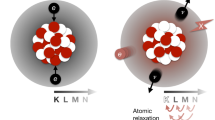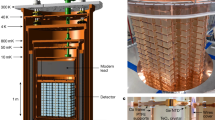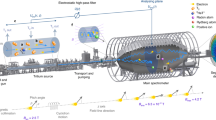Abstract
Many extensions of the Standard Model of particle physics explain the dominance of matter over antimatter in our Universe by neutrinos being their own antiparticles. This would imply the existence of neutrinoless double-β decay, which is an extremely rare lepton-number-violating radioactive decay process whose detection requires the utmost background suppression. Among the programmes that aim to detect this decay, the GERDA Collaboration is searching for neutrinoless double-β decay of 76Ge by operating bare detectors, made of germanium with an enriched 76Ge fraction, in liquid argon. After having completed Phase I of data taking, we have recently launched Phase II. Here we report that in GERDA Phase II we have achieved a background level of approximately 10−3 counts keV−1 kg−1 yr−1. This implies that the experiment is background-free, even when increasing the exposure up to design level. This is achieved by use of an active veto system, superior germanium detector energy resolution and improved background recognition of our new detectors. No signal of neutrinoless double-β decay was found when Phase I and Phase II data were combined, and we deduce a lower-limit half-life of 5.3 × 1025 years at the 90 per cent confidence level. Our half-life sensitivity of 4.0 × 1025 years is competitive with the best experiments that use a substantially larger isotope mass. The potential of an essentially background-free search for neutrinoless double-β decay will facilitate a larger germanium experiment with sensitivity levels that will bring us closer to clarifying whether neutrinos are their own antiparticles.
This is a preview of subscription content, access via your institution
Access options
Access Nature and 54 other Nature Portfolio journals
Get Nature+, our best-value online-access subscription
$29.99 / 30 days
cancel any time
Subscribe to this journal
Receive 51 print issues and online access
$199.00 per year
only $3.90 per issue
Buy this article
- Purchase on Springer Link
- Instant access to full article PDF
Prices may be subject to local taxes which are calculated during checkout




Similar content being viewed by others
References
Davidson, S., Nardi, E. & Nir, Y. Leptogenesis. Phys. Rep. 466, 105–177 (2008)
Mohapatra, R. N. & Smirnov, A. Y. Neutrino mass and new physics. Annu. Rev. Nucl. Part. Sci. 56, 569–628 (2006)
Mohapatra, R. N. et al. Theory of neutrinos: a white paper. Rep. Prog. Phys. 70, 1757–1867 (2007)
Päs, H. & Rodejohann, W. Neutrinoless double beta decay. New J. Phys. 17, 115010 (2015)
Agostini, M. et al. Results on neutrinoless double-β decay of 76Ge from phase I of the Gerda experiment. Phys. Rev. Lett. 111, 122503 (2013)
Cuesta, C. et al. Status of the Majorana demonstrator. AIP Conf. Proc. 1686, 020005 (2015)
Alfonso, K. et al. Search for neutrinoless double-beta decay of 130Te with CUORE-0. Phys. Rev. Lett. 115, 102502 (2015)
Andringa, S. et al. Current status and future prospects of the SNO+ experiment. Adv. High Energy Phys. 2016, 6194250 (2016)
Gando, A. et al. Search for Majorana neutrinos near the inverted mass hierarchy region with KamLAND-Zen. Phys. Rev. Lett. 117, 082503 (2016)
Albert, J. B. et al. Search for Majorana neutrinos with the first two years of EXO-200 data. Nature 510, 229–234 (2014)
Martin-Albo, J. et al. Sensitivity of NEXT-100 to neutrinoless double beta decay. J. High Energ. Phys. 1605, 159 (2016)
Mount, B. J., Redshaw, M. & Myers, E. G. Double-β-decay Q values of 74Se and 76Ge. Phys. Rev. C 81, 032501 (2010)
Ackermann, K.-H. et al. The GERDA experiment for the search of 0νββ decay in 76Ge. Eur. Phys. J. C 73, 2330 (2013)
Heusser, G. Low-radioactivity background techniques. Annu. Rev. Nucl. Part. Sci. 45, 543–590 (1995)
Klapdor-Kleingrothaus, H. V. et al. Search for neutrinoless double beta decay with enriched 76Ge in Gran Sasso 1990–2003. Phys. Lett. B 586, 198–212 (2004)
Aalseth, C. E. et al. IGEX 76Ge neutrinoless double beta decay experiment: prospect for next generation experiments. Phys. Rev. D 65, 092007 (2002)
Agostini, M. et al. Production, characterization and operation of 76Ge enriched BEGe detectors in GERDA. Eur. Phys. J. C 75, 39 (2015)
Agostini, M. et al. The background in the 0νββ experiment GERDA. Eur. Phys. J. C 74, 2764 (2014)
Agostini, M . et al. Upgrade of the GERDA experiment. In Proc. Sci. TIPP2014 109, https://pos.sissa.it/archive/conferences/213/109/TIPP2014_109.pdf (2014)
Riboldi, S. et al. Cryogenic readout techniques for germanium detectors. In Proc. 2015 4th Int. Conf. on Adv. in Nucl. Instrum. Meas. Methods and their Appl. (AMIMMA) http://ieeexplore.ieee.org/document/7465549 (2015)
Agostini, M. et al. LArGe: active background suppression using argon scintillation for the GERDA 0νββ-experiment. Eur. Phys. J. C 75, 506 (2015)
Janicskó Csáthy, J. et al. Optical fiber read-out for liquid argon scintillation light. Preprint at http://arXiv.org/abs/1606.04254 (2016)
Freund, K. et al. The performance of the Muon Veto of the GERDA experiment. Eur. Phys. J. C 76, 298 (2016)
Agostini, M., Pandola, L. & Zavarise, P. Off-line data processing and analysis for the GERDA experiment. J. Phys. Conf. Ser. 368, 012047 (2012)
Agostini, M. et al. GELATIO: a general framework for modular digital analysis of high-purity Ge detector signals. J. Instrum. 6, P08013 (2011)
Agostini, M. et al. Improvement of the energy resolution via an optimized digital signal processing in Gerda phase I. Eur. Phys. J. C 75, 255 (2015)
Agostini, M. et al. Results on ββ decay with emission of two neutrinos or majorons in 76Ge from Gerda phase I. Eur. Phys. J. C 75, 416 (2015)
Agostini, M. et al. Pulse shape discrimination for GERDA phase I data. Eur. Phys. J. C 73, 2583 (2013)
Budjáš, D. et al. Pulse shape discrimination studies with a broad-energy germanium detector for signal identification and background suppression in the Gerda double beta decay experiment. J. Instrum. 4, P10007 (2009)
Agostini, M. et al. Signal modeling of high-purity Ge detectors with a small read-out electrode and application to neutrinoless double beta decay search in 76Ge. J. Instrum. 6, P03005 (2011)
Wagner, V. Pulse Shape Analysis for the GERDA Experiment to Set a New Limit on the Half-life of 0νββ Decay of76Ge. PhD thesis, MPI-K and Univ. Heidelberg (2016); http://www.ub.uni-heidelberg.de/archiv/22621 (2017)
Kirsch, A. Search for the Neutrinoless Double β-decay in Gerda Phase I Using a Pulse Shape Discrimination Technique. PhD thesis, MPI-K and Univ. Heidelberg http://www.ub.uni-heidelberg.de/archiv/17149 (2014)
Bruyneel, B., Birkenbach, B. & Reiter, P. Pulse shape analysis and position determination in segmented HPGe detectors: the AGATA detector library. Eur. Phys. J. A 52, 70 (2016)
Agostini, M . et al. Limit on neutrinoless double beta decay of 76Ge by GERDA. Phys. Procedia 61, 828–837 (2015)
Menéndez, J. et al. Disassembling the nuclear matrix elements of the neutrinoless beta beta decay. Nucl. Phys. A 818, 139–151 (2009)
Horoi, M. & Neacsu, A. Shell model predictions for 124Sn double-β decay. Phys. Rev. C 93, 024308 (2016)
Barea, J., Kotila, J. & Iachello, F. 0νββ and 2νββ nuclear matrix elements in the interacting boson model with isospin restoration. Phys. Rev. C 91, 034304 (2015)
Hyvärinen, J. & Suhonen, J. Nuclear matrix elements for 0νββ decays with light or heavy Majorana-neutrino exchange. Phys. Rev. C 91, 024613 (2015)
Šimkovic, F. et al. 0νββ and 2νββ nuclear matrix elements, quasiparticle random-phase approximation, and isospin symmetry restoration. Phys. Rev. C 87, 045501 (2013)
López Vaquero, N., Rodriguez, T. R. & Egido, J. L. Shape and pairing fluctuation effects on neutrinoless double beta decay nuclear matrix elements. Phys. Rev. Lett. 111, 142501 (2013)
Yao, J. et al. Systematic study of nuclear matrix elements in neutrinoless double-beta decay with a beyond-mean-field covariant density functional theory. Phys. Rev. C 91, 024316 (2015)
Beringer, J. et al. Review of particle physics. Phys. Rev. D 86, 010001 (2012)
Cowan, G. et al. Asymptotic formulae for likelihood-based tests of new physics. Eur. Phys. J. C 71, 1554 (2011)
Feldman, G. J. & Cousins, R. D. Unified approach to the classical statistical analysis of small signals. Phys. Rev. D 57, 3873–3889 (1998)
Caldwell, A., Kollar, D. & Kröninger, K. BAT — the Bayesian Analysis Toolkit. Comput. Phys. Commun. 180, 2197–2209 (2009)
Cousins, R. & Highland, V. Incorporating systematic uncertainties into an upper limit. Nucl. Instrum. Methods Phys. Res. A 320, 331–335 (1992)
Biller, S. V. & Oser, S. M. Another look at confidence intervals: proposal for a more relevant and transparent approach. Nucl. Instrum. Methods Phys. Res. A 774, 103–119 (2015)
Acknowledgements
The GERDA experiment is supported by the German Federal Ministry for Education and Research (BMBF), the German Research Foundation (DFG) via the Excellence Cluster Universe, the Italian Istituto Nazionale di Fisica Nucleare (INFN), the Max Planck Society (MPG), the Polish National Science Centre (NCN), the Russian Foundation for Basic Research (RFBR) and the Swiss National Science Foundation (SNF). These research institutions acknowledge internal financial support. GERDA was constructed and commissioned by the authors of refs 13 and 19. The GERDA Collaboration (https://www.mpi-hd.mpg.de/gerda/) thanks the directors and the staff of the LNGS for their support of the GERDA experiment.
Author information
Authors and Affiliations
Consortia
Contributions
All authors contributed to the publication, being differently involved in the design and construction of the detector system, in its operation, and in the acquisition and analysis of data. All authors approved the final version of the manuscript. In line with collaboration policy, the authors are listed here alphabetically.
Ethics declarations
Competing interests
The author declare no competing financial interests.
Additional information
Reviewer Information Nature thanks P. Barbeau, L. Canonica and the other anonymous reviewer(s) for their contribution to the peer review of this work.
Publisher's note: Springer Nature remains neutral with regard to jurisdictional claims in published maps and institutional affiliations.
Extended data figures and tables
Extended Data Figure 1 GERDA Phase II experimental set-up.
a, Overview. 1, water tank with muon veto system PMTs (590 m3, diameter 10 m); 2, LAr cryostat (64 m3, diameter 4 m); 3, floor and roof of clean room; 4, lock; 5, glove box; 6, plastic muon veto system. b, LAr veto system: 1, bottom plate (diameter 49 cm) with 7 3-inch PMTs (R11065-10/20 MOD) with low radioactivity of U and Th (<2 mBq per PMT); 2, fibre curtain (height 100 cm) coated with wavelength shifter; 3, optical couplers and SiPMs; 4, thin-walled (0.1 mm) Cu cylinders (height 60 cm) covered with a Tyvek reflector on the inside; 5, top plate with properties as bottom plate 1 except for 9 3-inch PMTs; 6, calibration source entering slot in top plate; 7, slot for second of three calibration sources. c, Detector array. 1, Ge detectors arranged in 7 strings; 2, flexible bias and readout cables; 3, amplifiers. d, Detector module, view from bottom. 1, BEGe diode; 2, signal cable; 3, high voltage cable. 2 and 3 are attached by 4, bronze clamps to 5, silicon support plate; 6, bond wire connections from diode to signal and high voltage cable; 7, Cu support rods.
Extended Data Figure 2 Detector types.
Cross-section through the germanium detector types (left) and the corresponding photographs of them (right). The p+ electrode is made by a ∼0.3 μm thin boron implantation. The n+ electrode is a 1 to 2 mm thick lithium diffusion layer and is biased with up to +4,500 V. The electric field drops to zero in the n+ layer, and hence energy depositions in this fraction of the volume do not create a readout signal. The p+ electrode is connected to a charge sensitive amplifier.
Extended Data Figure 3 Germanium detector array.
Photograph of the assembled detector array, with a string of coaxial detectors on the left, and strings of BEGe detectors at middle and right. Each string is enclosed by a cylindrical nylon shroud covered with a wavelength shifter.
Extended Data Figure 4 Liquid argon veto set-up.
Photographs of the LAr veto system: left, fibre curtain with SiPM readout at the top; right, top and bottom arrangement of PMTs.
Extended Data Figure 5 Frequentist hypothesis test.
P value for the hypothesis test as a function of the inverse half-life  according to equation (7). The colour bands indicate the spread of the P-value distributions for many Monte Carlo realizations according to the GERDA parameters (with no signal): green and yellow show the central 68% and 90% probability intervals, respectively. The dashed black line represents the median of the distribution; the P value for the GERDA data is shown as a solid black line. The red arrows indicate the results at 90% confidence level, that is, a P value of 0.1: the limit for
according to equation (7). The colour bands indicate the spread of the P-value distributions for many Monte Carlo realizations according to the GERDA parameters (with no signal): green and yellow show the central 68% and 90% probability intervals, respectively. The dashed black line represents the median of the distribution; the P value for the GERDA data is shown as a solid black line. The red arrows indicate the results at 90% confidence level, that is, a P value of 0.1: the limit for  (full red arrow), and the median sensitivity for
(full red arrow), and the median sensitivity for  (dashed red arrow). For a detailed discussion of their computation, see Methods.
(dashed red arrow). For a detailed discussion of their computation, see Methods.
Rights and permissions
About this article
Cite this article
The GERDA Collaboration. Background-free search for neutrinoless double-β decay of 76Ge with GERDA. Nature 544, 47–52 (2017). https://doi.org/10.1038/nature21717
Received:
Accepted:
Published:
Issue Date:
DOI: https://doi.org/10.1038/nature21717
This article is cited by
-
Advances in nuclear detection and readout techniques
Nuclear Science and Techniques (2023)
-
Absolute neutrino mass scale and dark matter stability from flavour symmetry
Journal of High Energy Physics (2022)
-
Leptogenesis, fermion masses and mixings in a SUSY SU(5) GUT with D4 flavor symmetry
Journal of High Energy Physics (2021)
-
Cornering (quasi) degenerate neutrinos with cosmology
Journal of High Energy Physics (2020)
-
Evaluation of cosmogenic activation of copper and germanium during production in Jinping Underground Laboratory
Nuclear Science and Techniques (2020)
Comments
By submitting a comment you agree to abide by our Terms and Community Guidelines. If you find something abusive or that does not comply with our terms or guidelines please flag it as inappropriate.



